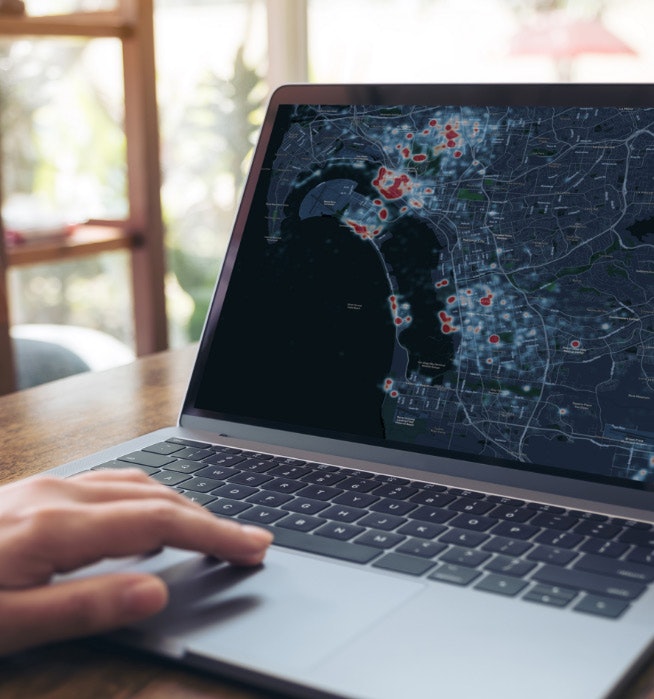
Comprehensive Airspace Security via the Cloud
SkySafe is an airspace security technology company that is building comprehensive, city-wide sensor networks that allow organizations to detect, identify, track, and analyze the drones in their airspace. This Cloud-based, SaaS platform puts real-time and historical drone data at your fingertips, without the need to acquire, install, or maintain expensive hardware.

What is Cloud-based Airspace Security?
As with any defense system, the key to airspace security is situational awareness. The defender must know how many drones are in an area, where they are, what type they are, and who is operating them. This requires an airspace management system capable of collecting, analyzing, and distributing this information. Without that airspace situational awareness, choosing the optimum countermeasure to stop a drone - or locating the launch point of the operator - becomes a matter of luck.
SkySafe Cloud combines several proven technologies to offer situational awareness and airspace security. One is the Cloud itself, which is routinely used by government and commercial customers who find it more efficient and cost effective than keeping IT administration services in-house.
SkySafe Cloud uses a city-wide network of radio frequency (RF) sensors that detect signals from drones and their operators. Unlike standalone counter-drone systems, SkySafe Cloud sends data to a central location for analysis and distribution. Users can then log into the Cloud to see what drones are in the coverage area and receive real-time alerts of unauthorized or anomalous UAS activity.
There are more than 1.78M registered drones in the US and the FAA reports that there are 2,500 reported drone incidents per year.
A major advantage of cloud-based airspace security is its adaptability. It is a service operated by professionals whose business is drone defense. They have the latest information on the technical characteristics of current and potential UAS threats. As a centralized hub, history and context can be provided - such as a record of past drone flights in their area. And as a cloud-based system, it is easily scalable for covering areas that experience heavy UAS traffic.
Nearly 10 million consumer drones will be shipped by 2030, according to one estimate. With more drones in the air - whether through malice or carelessness. there will be more threats to society.
Cloud-based airspace security Is Integrated.
One problem with standalone counter-drone systems is that they are vulnerable to single points of failure. SkySafe Cloud offers vital redundancy. An overlapping network of sensors, that feed into a centralized hub on the cloud, is not dependent on the exact placement of a single sensor.
Other advantages of cloud-based airspace security include:

- Expense: Users avoid the capital costs of purchasing and maintaining equipment such as RF sensors and network servers.
- Acquisition: Cloud-based airspace security technology offers immediate access to counter-drone defense, without the delays inherent in ordering equipment from manufacturers and deploying it. Particularly for organizations that face cumbersome budgeting processes, a subscription service can be a far quicker option.
- Access: With a cloud-based system, users can log in from anywhere.
- Wide coverage area: Standalone C-UAS involves fixed or mobile sites with limited range, which in turn makes exact placement of counter-drone assets important. By covering an area with multiple RF sensors, SkySafe Cloud can provide total coverage of the designated airspace, such as around a power plant, airfield, or prison.
- Tracking across multiple areas: Monitoring UAS movement between different sites is a challenge because contact can be lost between each local counter-drone system. SkySafe Cloud uses an integrated network of sensors, so coverage is continuous.
- Common operating picture: SkySafe Cloud users - wherever they are - can see a common display of UAS movements and status.
- Customization: Even for government users who must operate isolated networks, SkySafe Cloud can be designed as a private cloud service.
Drones are emerging as a threat to society.

Airports & Airlines
Airport operations can be disrupted by unauthorized UAS. In March of 2022, a British Airways flight came within 50ft of crashing into a large drone over North London, this incident was the highest possible risk - a Category A Near Miss.

Critical Infrastructure
Utilities and critical infrastructure sites must contend with potential threats that could affect operations. In July 2020, a drone crashed near a Pennsylvania electrical substation in what authorities said was a deliberate attempt to damage the power grid.

Sports Stadiums & Outdoor Events
Stadium owners must plan for casualties and mass panic if drones strike a sporting event or outdoor concert. In May 2017, a drone crashed into the bleachers at Petco Park.

Border Control
Law Enforcement and Border Control Authorities must contend with UAS smuggling drugs over the border. In April 2015, a single drone smuggled 28lbs of heroin over the US border near San Diego, CA.

Corrections
There are countless accounts of drones being used to smuggle drugs and weapons into prisons. In May 2021, 20 people were arrested for using drones to deliver over 100lbs of contraband to a South Carolina prison.

National Security
Our Nation needs unprecedented networked C-UAS to protect our airspace from drone threats both foreign and domestic.